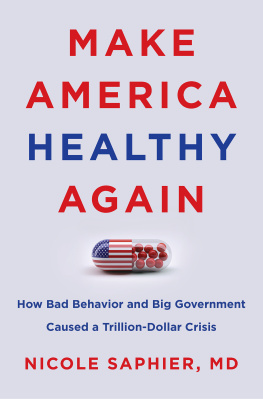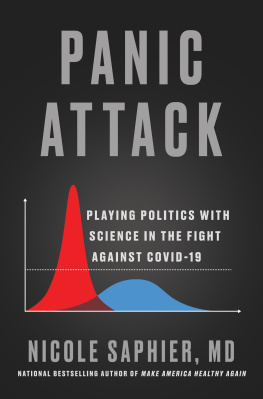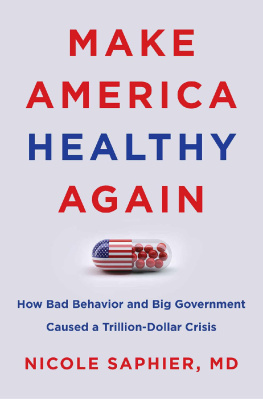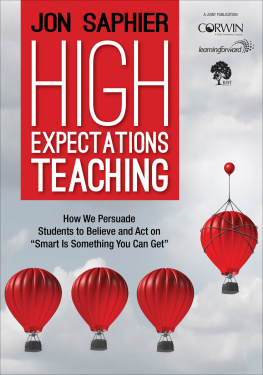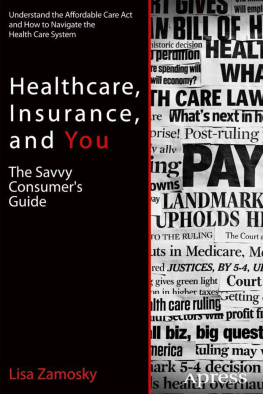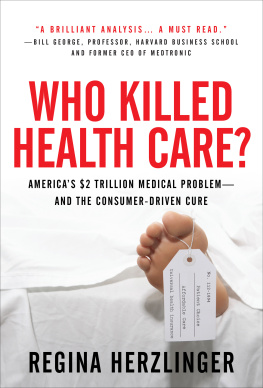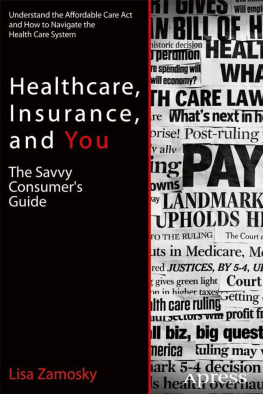Contents
For Nicholas Anthony, whose mere existence has been my greatest motivator.
For Hudson and Harrison, for insisting I play board games and read bedtime stories, despite delaying work on this book.
For Paul, who stands beside me every day, and lifts me up when I need a boost.
You cannot subsidize irresponsibility and expect people to become more responsible.
thomas sowell
America, we are in a crisis.
This is not about an existential or political crisis or an economic or religious tumult. We are in the midst of an absolute, head-on, health care crisis.
I admit its an unusual kind of crisis. In the past few years, research and ingenuity have yielded more advancements in the field of medicine than the decade before them. And that decade saw the rise of more technological wonders and advanced treatments than the century before it. In fact, by New Years Day 2000, the average life expectancy in the United States had almost doubled from what it had been on New Years Day 1900, rising from approximately forty-seven years to seventy-seven. It is wonderful that we were able to defy the laws of physics and safely send a man to the moon and back. But to double our lifespan in such a short period implies that we are on to something even greater: defying our own mortality.
As a physician, I witness firsthand every day how modern medicine has an impact on the lives of everyday people. However, the example closest to my heart is my own Uncle Joe.
He was a normal kid born to a normal family and grew up to be a normal man with normal kids and normal grandkids. That was not always the case for someone diagnosed with type 1 diabetes. Uncle Joe depended on a daily regimen of finger sticks and injections of insulin, a necessary hormone his own body deprived him of and without which he would have suffered a horrendous, early death. While that may not sound remarkable, consider the fact that had he been born just a few years earlier, this medicine would not have been available when he was a kid. He would likely not have survived to graduate college, let alone have his first son.
They say in life that timing is everything, and for Uncle Joe, this expression could not have been more spot-on. For while he was able to live into adulthood and raise his boys, years of battling diabetes caught up with his body, as it does with so many other of its victims. His kidneys failed, and he was again dying. This time, no medicine in the world would save him. What did save him, though, was a complicated surgical procedure in which he received a transplanted kidney and pancreas, the organ responsible for making the bodys own natural insulin. After surgery, his kidney functioned at full strength, and his own body was making enough insulin so that he no longer needed to take the daily injections. Had his kidneys failed a decade before, he may have gone on daily dialysis with an average life expectancy of only a few years, and he would never have seen his first grandson.
Being born in the right year and suffering a condition at the right time allowed Uncle Joe to receive medical therapy that allowed him not only to live but to thrive. When his transplanted kidney began to failas often happens after a decade of extended lifehe was again fortunate. He underwent a successful repeat kidney transplant, possible only by the advanced surgical technique, and even more revolutionary genetic sequencing technology identifying his own son as a 100 percent ideal match.
Uncle Joe was the lucky recipient of a breakthrough medicine that replaced his own bodys missing insulin, a revolutionary surgery transplanting a functional kidney and pancreas, allowing him to survive a horrible demise from a crippled organ, and ultimately genomic sequencing pushed his life expectancy beyond another decade. All of these mortality-defying therapies had not been available the decade prior. He was always there at the right time.
However, at the same time that weve made so much progress, our costs have also been growing.
Each presidential administration during my lifetime and many before trumpeted that we are on the verge of a disaster. On October 10, 1952, President Dwight Eisenhower gave a speech in Salt Lake City in which he reiterated his opposition to socialized medicine while also recognizing that all Americans deserve basic medical care and that the system needed reform.
However, it wasnt until July 10, 1969, that President Richard Nixon proclaimed, We face a massive crisis in this area. Without prompt administrative and legislative action, we will have a breakdown in our medical care system. This was considered the first time an administration declared such an emergency and it not only was a pivotal moment for health care but also marked the first attempt at a comprehensive health care reform.
Ronald Reagan, a hero of so many present-day Republicans, was even willing to raise taxes to expand the government program Medicare. While I am opposed to socialized medicine, I have always felt that medical care should be available to those who cannot otherwise afford it. Although eager to recover from a difficult midterm election in 1982, Reagans Medicare expansion might have been too generous for the nations own good, causing continued rises in taxes and allotments for Medicare and Medicaid.
As the costs continued to soar, health care was further discussed by Barack Obama when he addressed Congress in 2009. Our collective failure to meet this challengeyear after year, decade after decadehas led us to a breaking point. The latest report from the Centers for Medicare and Medicaid Services (CMS), published recently in Health Affairs, estimates national health expenditures will reach 20 percent of the gross domestic product (GDP) by 2027, and it included a series of colorful charts demonstrating theories on how and why costs have risen. The New York Times, the Wall Street Journal, and even the New York Post were quick to pick up on this headline and used even more flair to highlight that America is going bankrupt and that our health system is to blame for it. The problem is that the report and various media outlets failed to note an important point regarding their latest catastrophic projections: We are not in an immediate crisis, rather we are nearing our fifth decade of a growing problem.
It would be easy to think that innovation has driven these increased costs. However, pharmaceutical and medical device costs account for approximately 4 percent of the increased health care cost each year. The cost to develop and produce these novel discoveries is only one of the drivers of the rise in costs.
Health care in the United States now resembles a business venture and, like all successful business ventures, to function it must acquire administrative staff, legal counselors, information and technology specialists, marketing personnel, and an abundance of ancillary staff. This organizational compound, while good for overseers, adds on remarkable nonmedical expenses to the total cost of care, thus increasing health care spending. Therefore, it is not surprising that the highest-paid entities in health care today are not physicians, but corporate executives and high-level administrators.
Health care commercial greed is best reflected when evaluating the acquisition of drug rights, which is separate from the research and development of pharmaceuticals. There are numerous medications that small start-up companies buy the marketing rights to, and then increase the price for profit. These small companies do not have the burden of significant R&D debt as the original company did upon inventing the drugs. To recover the cost of acquiring the drugs rights and to make revenue, the small companies will increase the cost of the acquired medication. Sometimes the price rise is subtle over a period, but other times the price is increased abruptly, leaving many patients unable to afford the medication and facing the choice of having to forgo treatment.

